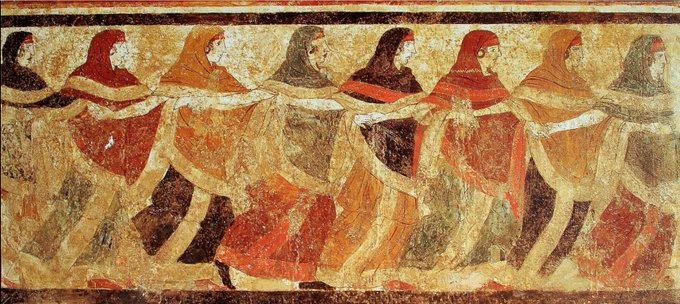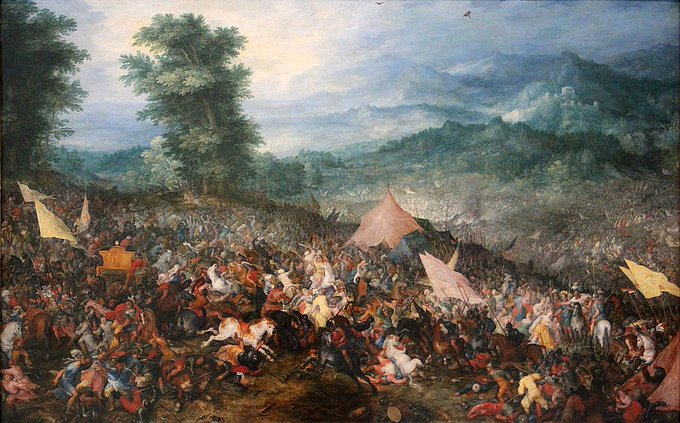BceのTwitterイラスト検索結果。 346 件中 10ページ目
- Isis-Aphrodite (Greek, Etruscan & Roman)
- Clay icon Goddess figure from Hacilar VI, circa 5400 BCE, Western Turkey
- Green Tara, 13th century, Tibet
- Goddess Idol Yalangash, South Turkmenia, 4000 BCE
Today in #history: Second Punic War: Battle of the Trebia: Hannibal's Carthaginian forces defeat those of the Roman Republic. (218 BCE) #OnThisDay
Read more: https://t.co/VQ4o04VFN8
Image: © by The Creative Assembly
@paudraws I have so many, but this lady here is the one I've put the most work into with developing a story. I'm slowly writing a book about her!
Based around 30 BCE, from Egypt. Raised in unfortunate circumstances, she's a little spitfire that fights for her freedom. Small, but mighty!
Dancing Peucetian women. Tomb of the dancers, Ruvo di Puglia, Italy. C5th/C4th BCE. Now @MANNapoli
Peucetians - people in ancient Apulia (between Bari & Tarentum).
#ItalyBeforeTheRomans
The colours & movement of this painting are so spectacular!
#MuseumsUnlocked #Dance
Aesop (620–564 BCE) was a Greek fabulist who “made use of humble incidents to teach great truths” according to philosopher Apollonius of Tyana. Animals feature prominently in Aesop’s fables. These illustrations: Alice and Martin Provensen, published in 1965. #FairytaleTuesday
apollo playing the lyre c. 510 bce and apollo and the muses (details) by michel dorigny c. 1640
Last but not least: Shadow from Illusion of Gaia/Time. I love the burning effect on him.
Colors: 809BCE 95B8D1 B8E0D2 D6EADF EAC4D5
#5ColorChallenge #IllusionOfTime #IllusionOfGaia #SNES
GARGI VACHAKNAVI -Celebrating Women Of India (every Thursday)
Gargi Vachaknavi (born about 9th to 7th century BCE) was an ancient Indian philosopher. In Vedic literature, she is honored as a great natural philosopher, renowned expounder of the Vedas, ..
thinking about Jar with anthropomorphic feet - earthenware - 6 ¼ ″ x 4 9⁄16 ″ - Qijia culture, China - c. 2300-1500 BCE
#HowIUseReference ✨ A few examples from #aCompendiumOfWitches
(🧵thread)
Viduca, I century BCE Gaul
Today in #history: Alexander the Great defeats Darius III of Persia in the Battle of Gaugamela. (331 BCE) #OnThisDay
Read more: https://t.co/RTtRXCZuq1
Wonderful interior of a Greek vase showing Odysseus giving Neoptolemos the arms of his father Achilles, painted by Douris & attributed to Python as potter, Athens 500-450BCE, found in Cerveteri, now in Vienna. The exterior shows the contest for the arms between Odysseus & Ajax
A scene depicted on a wall painting from the Theban tomb of the 18th Dynasty high official Nebamun, who lived around 1350 BCE. Nebamun is shown hunting birds, in a small boat with his wife Hatshepsut & their young daughter, in the marshes of the Nile. 1/3
Remains of a painted plaster pavement from a palace of Akhenaten. New Kingdom, 18th Dynasty, Amarna Period, reign of Akhenaten, ca. 1353-1336 BCE. Now in the Egyptian Museum, Cairo. JE 33030/1 #Egypt #Archaeology
What an excellent amber carving! Look at the details, a small bottle held by a woman!
This is an Etruscan sculpture made ~5th C BCE, depicting a couple on the sofa. Woman is dressed in a pointed hat, a tunic & pointed shoes.
Ones a fibula - amber has 2 holes on the back side
1/ https://t.co/TYKHLzee8I
The Minoan Civilization existed from roughly 3000 BCE (Before the Common Era) through 1450 BCE. That’s about 5000 years ago!
Saffron Wave takes place in 1625 BCE, a few hundred years before the general time frame for the collapse of the civilization, before the Mycenaean Greeks.















































